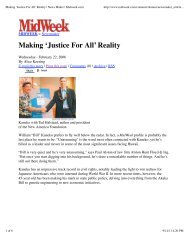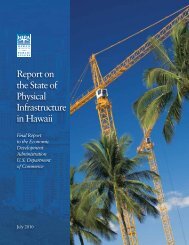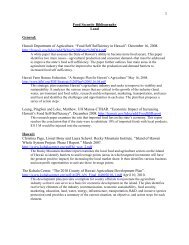Hawai'i Fisheries Initiative - The Hawaii Institute for Public Affairs
Hawai'i Fisheries Initiative - The Hawaii Institute for Public Affairs
Hawai'i Fisheries Initiative - The Hawaii Institute for Public Affairs
You also want an ePaper? Increase the reach of your titles
YUMPU automatically turns print PDFs into web optimized ePapers that Google loves.
United Nations World Heritage status,<br />
concluding that such designation would<br />
commit the federal government in<br />
perpetuity to preservation/conservation<br />
ef<strong>for</strong>ts and add an extra layer of national<br />
and international protection, increase<br />
international recognition and financial<br />
support, and increase opportunities<br />
<strong>for</strong> research and education now and<br />
into the future. 522<br />
Government, Native <strong>Hawaii</strong>ans,<br />
and Cultural and Community<br />
Organizations Seek Cooperative<br />
Management of Ocean Resources<br />
Consensus building between the different<br />
factions (international, federal, state,<br />
local community, and native peoples)<br />
is becoming a global message in<br />
marine management. Community-based<br />
management is a buzzword of the day,<br />
signifying not only the rights of Native<br />
<strong>Hawaii</strong>ans, but of all residents in coastal<br />
communities in having a say in marine<br />
management. Yet, working examples<br />
remain relatively rare. “A few remote<br />
areas under community control have<br />
standing stocks of fishes equivalent to<br />
those found in no-take Marine Life Conservation<br />
Districts. However, despite the fact<br />
that no-take marine refuges and areas<br />
under community-based management<br />
have proven to be successful fisheries<br />
management strategies, less than 1 percent<br />
of the coastal areas in Hawai‘i are managed<br />
in these ways. 523<br />
However, successful cooperativemanagement<br />
models do exist. Examples of<br />
subsistence-fishing community management<br />
ef<strong>for</strong>ts in Hawai‘i include Ha‘ena on<br />
Kaua‘i; Ho‘okena, Miloli‘i, and Honaunau<br />
on Hawai‘i; Mo‘omomi on Moloka‘i;<br />
and Ewa on O‘ahu. 524 <strong>The</strong> Makai Watch<br />
program, modeled after the Neighborhood<br />
Watch program, acts as the “eyes and<br />
ears” of law en<strong>for</strong>cement by providing<br />
local communities with the opportunity<br />
to be directly involved in protecting the<br />
marine environment. <strong>The</strong> program, which<br />
is a partnership between <strong>The</strong> Nature<br />
Conservancy, the University of Hawai‘i<br />
Sea Grant, DAR, and non-profits such as<br />
Ma – lama Hawai‘i, educates marine users as<br />
to marine ecology, culture, history, safety,<br />
and conscientious use of ocean resources.<br />
Monitors collect in<strong>for</strong>mation on fishing,<br />
kayaking, and collecting activities and on<br />
the biological health of the ocean resource.<br />
Makai Watch participants encourage others<br />
to learn and obey regulations, and they<br />
also identify and report illegal activities to<br />
proper authorities. 525<br />
NOAA’s Pacific Services Center was<br />
established in 2001 to improve the<br />
agency’s services to the Pacific Islands<br />
through partnering with local coastal and<br />
ocean resource management communities<br />
as a means of understanding and<br />
developing assistance that reflects and<br />
incorporates the islands’ cultural and<br />
traditional practices. “Natural resource<br />
management issues cannot be separated<br />
from human elements such as traditional<br />
practices, culture, and economics.” 526<br />
105







